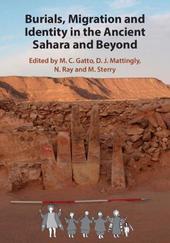
|
Burials, Migration and Identity in the Ancient Sahara and Beyond
Hardback
Main Details
| Title |
Burials, Migration and Identity in the Ancient Sahara and Beyond
|
| Authors and Contributors |
Edited by M. C. Gatto
|
|
Edited by D. J. Mattingly
|
|
Edited by N. Ray
|
|
Edited by M. Sterry
|
| Series | Trans-Saharan Archaeology |
|---|
| Physical Properties |
| Format:Hardback | | Pages:586 | | Dimensions(mm): Height 256,Width 184 |
|
| Category/Genre | African history
Archaeology by period and region |
|---|
| ISBN/Barcode |
9781108474085
|
| Classifications | Dewey:966 |
|---|
| Audience | | Professional & Vocational | |
|---|
| Illustrations |
Worked examples or Exercises; 22 Tables, black and white; 19 Maps; 66 Halftones, black and white; 64 Line drawings, black and white
|
|
Publishing Details |
| Publisher |
Cambridge University Press
|
| Imprint |
Cambridge University Press
|
| Publication Date |
14 February 2019 |
| Publication Country |
United Kingdom
|
Description
This ground-breaking volume explores a series of inter-related key themes in Saharan archaeology and history. Migration and identity formation can both be approached from the perspective of funerary archaeology, using the combined evidence of burial structures, specific rites and funerary material culture, and integrated methods of skeletal analysis including morphometrics, palaeopathology and isotopes. Burial traditions from various parts of the Sahara are compared and contrasted with those of the Nile Valley, the Maghreb and West Africa. Several chapters deal with the related evidence of human migration derived from linguistic study. The volume presents the state of the field of funerary archaeology in the Sahara and its neighbouring regions and sets the agenda for future research on mobility, migration and identity. It will be a seminal reference point for Mediterranean and African archaeologists, historians and anthropologists as well as archaeologists interested in burial and migration more broadly.
Author Biography
M. C. Gatto is an Honorary Visiting Fellow of the University of Leicester specialising in the prehistoric and historic archaeology of the Nile Valley and the Sahara. D. J. Mattingly is Professor of Roman Archaeology at the University of Leicester. He has worked in the Sahara for almost forty years and is the author of many books and articles related to Saharan archaeology, such as Farming the Desert (2 vols, 1996), which won the James R. Wiseman book award of the American Institute of Archaeology, and The Archaeology of Fazzan series (4 volumes, 2003-13). He was the PI of the European Research Council-funded Trans-Sahara Project (2011-17) which lies behind this volume and is overall series editor of Trans-Saharan Archaeology, in which it is the second of four projected volumes. N. Ray is an archaeologist who specialises in the Roman economy, consumption, and funerary archaeology in North Africa. He is the Assistant Director of the Oxford Roman Economy Project at the University of Oxford and previously worked as a Research Associate on the Trans-Sahara Project at the University of Leicester. He has co-edited several books, including De Africa Romaque (2016). M. Sterry is Assistant Professor in Roman Landscape Archaeology and GIS at the University of Durham. His research on the archaeology of the Sahara and North Africa makes particular use of GIS and remote sensing. He has undertaken fieldwork on various projects in Italy, Britain, Libya, and most recently southern Morocco, where he is co-director of the Middle Draa Project. He has published many articles on the Libyan Fazzan, Saharan trade, urbanization, and oasis settlements.
Reviews'In Burials, Migration, and Identity in the Ancient Sahara and Beyond, Gatto, Mattingly, Ray, and Sterry bring together diverse datasets from all corners of the desert using an explicitly trans-Saharan approach. Inspired by developments in Mediterranean archaeology, they reframe the desert as a great interconnected sea that can only be understood in relation to its 'shorelands' on its eastern, northern, and southern peripheries. Instead of standing outside the desert looking in, as scholars and historians have done for centuries, this book is set within the Sahara looking out. Through this approach, the editors seek to understand how events and processes within this network shaped human lives across space and time.' E. A. Sawchuk, African Archaeological Review
|